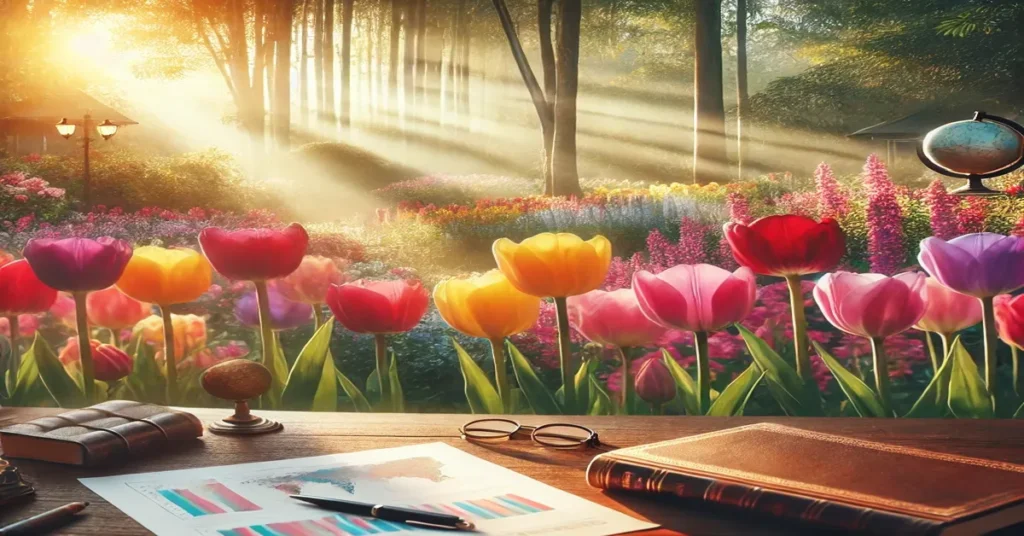Tulipanes, or tulips, are among the most celebrated flowers in the world, admired for their vibrant colors, graceful shapes, and rich history. These iconic blooms have captured the hearts of gardeners, artists, and flower enthusiasts for centuries. From their origins in Central Asia to their prominence in global trade and culture, tulips have a story that is as captivating as their appearance. This article explores the history, cultivation, symbolism, and significance of tulips, offering a comprehensive guide for enthusiasts and curious readers alike.
The History of Tulipanes
Origins in Central Asia
Tulips are believed to have originated in the mountainous regions of Central Asia, where they grew wild in a variety of colors and forms. The name “tulip” is derived from the Persian word tûlbend, meaning turban, as the flower’s shape resembles the traditional headwear.
Introduction to the Ottoman Empire
The Ottoman Empire played a crucial role in the cultivation and spread of tulips. By the 16th century, tulips had become a symbol of wealth and prestige in the empire, adorning palace gardens and inspiring works of art. The period of tulip obsession in the Ottoman Empire is often referred to as the “Tulip Era.”
Tulip Mania in Europe
Tulips were introduced to Europe in the late 16th century, quickly gaining popularity among the elite. By the 17th century, the Netherlands became the epicenter of tulip cultivation and trade. The period known as “Tulip Mania” saw bulbs traded for exorbitant prices, sometimes exceeding the value of a house. Although the bubble eventually burst, the tulip remained a cherished symbol in Dutch culture.
Tulip Cultivation: How to Grow and Care for Tulipanes
Tulips are relatively easy to grow, making them a favorite among gardeners worldwide. Here are some essential tips for cultivating tulips:
1. Choosing the Right Bulbs
Select high-quality bulbs from reputable suppliers. Larger bulbs typically produce bigger and more vibrant blooms.
2. Planting Time
Tulips should be planted in the fall, approximately 6-8 weeks before the ground freezes. This allows the bulbs to establish roots before winter.
3. Soil Preparation
Tulips thrive in well-draining soil. Add organic matter, such as compost or peat moss, to improve soil quality.
4. Planting Depth and Spacing
Plant tulip bulbs about 6-8 inches deep and 4-6 inches apart. Position the pointed end of the bulb upward.
5. Watering and Care
Water the bulbs after planting to help them settle into the soil. During the growing season, ensure they receive adequate water but avoid overwatering.
6. Post-Bloom Care
After the tulips have bloomed, allow the foliage to die back naturally. This helps the bulbs store energy for the next growing season.
Varieties of Tulipanes
Tulips come in a stunning array of varieties, offering something for every taste and garden style. Here are some popular types:
1. Single Early Tulips
These tulips bloom early in the season and feature simple, elegant flowers in a wide range of colors.
2. Double Late Tulips
Known for their lush, peony-like blooms, these tulips add a touch of luxury to any garden.
3. Parrot Tulips
With fringed and ruffled petals, parrot tulips create a dramatic and exotic look.
4. Triumph Tulips
A classic choice for gardens and bouquets, triumph tulips are known for their sturdy stems and vibrant colors.
5. Darwin Hybrid Tulips
These tulips are prized for their large flowers and long-lasting blooms, making them a popular choice for landscapes.
Symbolism and Meaning of Tulipanes
Tulips have been associated with various meanings and symbols throughout history. Their significance often depends on their color:
- Red Tulips: Symbolize deep love and passion.
- Yellow Tulips: Represent happiness and cheerfulness.
- White Tulips: Convey purity and forgiveness.
- Purple Tulips: Signify royalty and admiration.
- Pink Tulips: Express affection and good wishes.
In addition to their color symbolism, tulips are often associated with spring, renewal, and the fleeting nature of life, as their blooms are short-lived but intensely beautiful.
Tulipanes in Art and Culture
Tulips have inspired countless artists, writers, and designers over the centuries. Here are some notable examples:
1. Dutch Golden Age Art
During the 17th century, Dutch painters like Jan Brueghel the Elder and Jacob Marrel immortalized tulips in their still-life paintings. These works celebrated the beauty and elegance of the flower.
2. Turkish Textiles and Ceramics
In the Ottoman Empire, tulips were a recurring motif in textiles, ceramics, and architecture, reflecting their cultural significance.
3. Literature and Poetry
Tulips have been featured in poetry and literature as symbols of love, beauty, and transience. They often serve as metaphors for life’s fleeting moments.
4. Modern Design
Tulip motifs continue to influence modern design, from fashion and home decor to branding and advertising.
Tulip Festivals Around the World
Tulip festivals celebrate the beauty and cultural importance of this beloved flower. Here are some of the most famous festivals:
1. Keukenhof, Netherlands
Known as the “Garden of Europe,” Keukenhof is home to millions of tulips and attracts visitors from around the globe.
2. Canadian Tulip Festival, Ottawa
This festival celebrates the historic bond between Canada and the Netherlands, featuring vibrant tulip displays and cultural events.
3. Istanbul Tulip Festival, Turkey
Held in the city where tulips first gained prominence, this festival showcases the flower’s cultural heritage.
4. Skagit Valley Tulip Festival, USA
Located in Washington State, this festival features breathtaking tulip fields and family-friendly activities.
Interesting Facts About Tulipanes
- Tulips are edible and were consumed during times of famine in Europe.
- There are over 3,000 registered varieties of tulips.
- Tulips are phototropic, meaning they grow towards light sources.
- The “Queen of the Night” tulip is one of the darkest varieties, appearing almost black.
- Tulips were once more valuable than gold during the height of Tulip Mania.
Conclusion
Tulipanes are more than just beautiful flowers; they are a symbol of history, culture, and nature’s fleeting beauty. From their humble beginnings in Central Asia to their celebrated status in gardens and art worldwide, tulips continue to captivate and inspire. Whether you’re a gardener, an art enthusiast, or simply someone who appreciates nature’s wonders, tulips offer endless fascination and joy.
FAQs
1. When is the best time to plant tulips?
The best time to plant tulip bulbs is in the fall, about 6-8 weeks before the ground freezes.
2. Can tulips grow indoors?
Yes, tulips can be forced to bloom indoors by planting bulbs in pots and simulating winter conditions.
3. How long do tulip blooms last?
Tulip blooms typically last 1-2 weeks, depending on the variety and weather conditions.
4. Are tulips toxic to pets?
Yes, tulips contain compounds that can be toxic to cats and dogs if ingested.
5. What are the most popular tulip varieties?
Popular varieties include Single Early, Double Late, Parrot, Triumph, and Darwin Hybrid tulips.
6. How do I prevent animals from digging up tulip bulbs?
You can protect tulip bulbs by placing a wire mesh over the planting area or using animal repellents.







